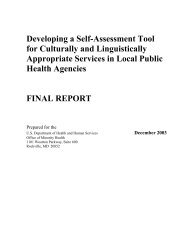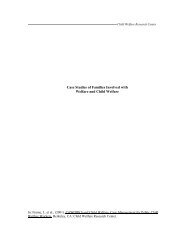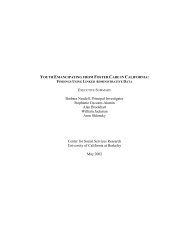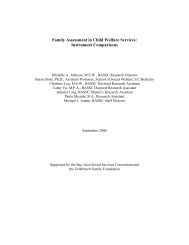Predictors of Resilience in Maltreated and Nonmaltreated Latino ...
Predictors of Resilience in Maltreated and Nonmaltreated Latino ...
Predictors of Resilience in Maltreated and Nonmaltreated Latino ...
Create successful ePaper yourself
Turn your PDF publications into a flip-book with our unique Google optimized e-Paper software.
placed <strong>in</strong> groups consist<strong>in</strong>g <strong>of</strong> three counselors (one head counselor <strong>and</strong><br />
two co-counselors) <strong>and</strong> 6–8 children who were matched accord<strong>in</strong>g to age<br />
<strong>and</strong> gender. The percentages <strong>of</strong> maltreated <strong>and</strong> nonmaltreated children <strong>in</strong><br />
the groups were approximately equal (50% maltreated <strong>and</strong> 50% nonmaltreated).<br />
With<strong>in</strong> the groups, many different ethnicities (e.g., African American,<br />
Lat<strong>in</strong>o, European American) were represented among the children.<br />
New groups <strong>of</strong> children attended the camp every week.<br />
A typical camp day lasted 7 hr, result<strong>in</strong>g <strong>in</strong> 35 hr <strong>of</strong> <strong>in</strong>teraction between<br />
the children <strong>and</strong> the counselors dur<strong>in</strong>g the week. In addition to recreational<br />
activities, the children also were asked to participate <strong>in</strong> a variety <strong>of</strong> research<br />
assessments. Child assent was obta<strong>in</strong>ed prior to any adm<strong>in</strong>istration <strong>of</strong><br />
research assessments. Research assistants were tra<strong>in</strong>ed <strong>in</strong> adm<strong>in</strong>ister<strong>in</strong>g<br />
assessments such as the Peabody Picture Vocabulary Test—Revised<br />
(PPVT–R) to <strong>in</strong>dividual children (see the follow<strong>in</strong>g section). Camp counselors<br />
completed a variety <strong>of</strong> assessments that measured their <strong>in</strong>teractions<br />
with, <strong>and</strong> observations <strong>of</strong>, the children assigned to their respective groups.<br />
Measures<br />
Maltreatment Classification System<br />
In order to determ<strong>in</strong>e children’s maltreatment experiences, cod<strong>in</strong>g <strong>of</strong><br />
MCDHHS records was conducted by tra<strong>in</strong>ed research assistants, doctoral<br />
students, <strong>and</strong> PhD-level psychologists us<strong>in</strong>g the Maltreatment Classification<br />
System (MCS) developed at the Mt. Hope Family Center (Barnett et<br />
al., 1993). The MCS uses MCDHHS records detail<strong>in</strong>g <strong>in</strong>vestigations <strong>and</strong><br />
f<strong>in</strong>d<strong>in</strong>gs regard<strong>in</strong>g maltreatment occurrences <strong>in</strong> identified families. Rather<br />
than rely<strong>in</strong>g on <strong>of</strong>ficial designations <strong>and</strong> case dispositions, the MCS codes<br />
all <strong>in</strong>formation available on a designated family from MCDHHS records,<br />
mak<strong>in</strong>g <strong>in</strong>dependent determ<strong>in</strong>ations <strong>of</strong> maltreatment experiences. (See<br />
Manly, Kim, Rogosch, & Cicchetti, 2001, for a more detailed explanation<br />
<strong>of</strong> this cod<strong>in</strong>g system.)<br />
Among the maltreated sample <strong>of</strong> Lat<strong>in</strong>o children <strong>in</strong> this study, 74.6%<br />
experienced physical neglect, 83.1% experienced emotional maltreatment,<br />
66.2% experienced physical abuse, <strong>and</strong> 15.5% experienced sexual abuse.<br />
Consistent with previous maltreatment literature, there was a high comorbidity<br />
<strong>of</strong> multiple subtypes among the maltreated Lat<strong>in</strong>o sample. Multiple<br />
subtypes were experienced by 77.6% <strong>of</strong> the Lat<strong>in</strong>o children. Because <strong>of</strong> the<br />
high comorbidity among the maltreatment subtypes, discrete subgroups for<br />
use <strong>in</strong> subtype comparisons were not feasible.<br />
Counselor Measures<br />
Camp counselors each evaluated the children <strong>in</strong> their respective groups<br />
by provid<strong>in</strong>g assessments <strong>of</strong> <strong>in</strong>dividual child function<strong>in</strong>g. The counselors<br />
were each tra<strong>in</strong>ed on how to complete the assessments described below,<br />
<strong>and</strong> counselors conducted their rat<strong>in</strong>gs <strong>of</strong> the children <strong>in</strong>dependently at the<br />
end <strong>of</strong> each week, after 35 hr <strong>of</strong> <strong>in</strong>teraction with the children. Interrater<br />
determ<strong>in</strong>ations were made by comput<strong>in</strong>g Cronbach’s alphas among the<br />
raters <strong>in</strong> each camp group. Individual counselor measures were averaged<br />
for each <strong>in</strong>dividual child, thus comb<strong>in</strong><strong>in</strong>g the <strong>in</strong>dependent perspectives <strong>of</strong><br />
two to three different adult raters.<br />
Behavior rat<strong>in</strong>gs (Wright, 1983). Counselors rated the behavior <strong>of</strong><br />
<strong>in</strong>dividual children on n<strong>in</strong>e items that assessed three different aspects <strong>of</strong><br />
<strong>in</strong>terpersonal function<strong>in</strong>g: prosocial behavior, aggression, <strong>and</strong> withdrawal.<br />
Seven-po<strong>in</strong>t rat<strong>in</strong>gs were completed each day <strong>and</strong> based on 45-m<strong>in</strong> observations<br />
<strong>of</strong> children <strong>in</strong> unstructured <strong>and</strong> structured camp sett<strong>in</strong>gs (e.g.,<br />
sports, art, free play). Interrater reliabilities across the years <strong>of</strong> assessment<br />
(1986–2000) ranged from .67 to .85 for prosocial behavior, from .70 to .88<br />
for aggression, <strong>and</strong> from .65 to .80 for withdrawal. Individual counselor<br />
assessments were averaged together to generate <strong>in</strong>dividual child scores for<br />
each <strong>of</strong> the three scales.<br />
Pupil Evaluation Inventory (PEI; Pekarik, Pr<strong>in</strong>z, Liebert, We<strong>in</strong>traub, &<br />
Neale, 1976). Counselors completed the PEI at the end <strong>of</strong> each week. The<br />
PEI makes use <strong>of</strong> a nom<strong>in</strong>ation technique <strong>and</strong> consists <strong>of</strong> 35 items that<br />
assess social behavior. It yields three homogeneous <strong>and</strong> stable factors:<br />
PREDICTORS OF RESILIENCE IN LATINO CHILDREN<br />
341<br />
Aggression, Withdrawal, <strong>and</strong> Likability. Counselors nom<strong>in</strong>ated up to 2<br />
children <strong>in</strong> their groups who were characterized best by each <strong>in</strong>dividual<br />
item. Interrater reliabilities across camp years ranged from .88 to .90.<br />
Aggregate scores for each <strong>of</strong> the three scales were generated on the basis<br />
<strong>of</strong> the number <strong>of</strong> nom<strong>in</strong>ations each child received on the respective scale<br />
items. Scores were then averaged across counselors to obta<strong>in</strong> three subscale<br />
scores per child.<br />
Teacher Report Form <strong>of</strong> the Child Behavior Checklist (TRF; Achenbach,<br />
1991b). At the end <strong>of</strong> each camp week, counselors rated each child’s<br />
behavioral symptomatology by complet<strong>in</strong>g the TRF (a teacher-completed<br />
version <strong>of</strong> the Child Behavior Checklist; Achenbach, 1991a). The TRF is<br />
a widely used <strong>and</strong> validated <strong>in</strong>strument for assess<strong>in</strong>g behavioral disturbance<br />
from the perspective <strong>of</strong> teachers. In the present study, because camp<br />
counselors were able to observe behaviors similar to those observed by<br />
teachers, camp counselors completed the measure to provide an analogous<br />
assessment <strong>of</strong> child function<strong>in</strong>g by an adult external to the family. The TRF<br />
conta<strong>in</strong>s 118 items rated for frequency that assess two broadb<strong>and</strong> dimensions<br />
<strong>of</strong> child symptomatology: externaliz<strong>in</strong>g behavioral problems (e.g.,<br />
del<strong>in</strong>quent <strong>and</strong> aggressive behavior) <strong>and</strong> <strong>in</strong>ternaliz<strong>in</strong>g behavioral problems<br />
(e.g., withdrawal, anxiety–depression, <strong>and</strong> somatic compla<strong>in</strong>ts). The scores<br />
for each child, <strong>in</strong> each group, were averaged among counselors to obta<strong>in</strong><br />
<strong>in</strong>dividual child scores for both <strong>in</strong>ternaliz<strong>in</strong>g <strong>and</strong> externaliz<strong>in</strong>g behavior<br />
problems. Interrater reliabilities ranged from .83 to .91 for externaliz<strong>in</strong>g<br />
behavior problems <strong>and</strong> from .70 to .88 for <strong>in</strong>ternaliz<strong>in</strong>g behavior problems.<br />
California Child Q-Set (CCQ; J. H. Block & Block, 1969). At the end<br />
<strong>of</strong> each week, the three counselors <strong>in</strong> each group <strong>in</strong>dependently completed<br />
the CCQ for each child <strong>in</strong> their respective group on the basis <strong>of</strong> their<br />
week-long <strong>in</strong>tensive <strong>in</strong>teractions with <strong>and</strong> observations <strong>of</strong> the children. The<br />
CCQ consists <strong>of</strong> 100 diverse items about the personality, cognitive, <strong>and</strong><br />
social characteristics <strong>of</strong> children. Raters sort the <strong>in</strong>dividual items pr<strong>in</strong>ted on<br />
cards <strong>in</strong>to a fixed distribution <strong>of</strong> piles depict<strong>in</strong>g n<strong>in</strong>e categories rang<strong>in</strong>g<br />
from most to least characteristic <strong>of</strong> the <strong>in</strong>dividual child. Thus, <strong>in</strong>dividual<br />
pr<strong>of</strong>iles consist<strong>in</strong>g <strong>of</strong> the 100 items are generated for each child. Interrater<br />
agreement ranged from .68 to .86. Two-dimensional scores are derived<br />
from the Q-set data: ego-resiliency <strong>and</strong> ego-control. On the basis <strong>of</strong> pr<strong>of</strong>iles<br />
for prototypical children display<strong>in</strong>g high ego-resiliency <strong>and</strong> high egoundercontrol,<br />
each item was assigned a criterion score for each respective<br />
dimension (J. H. Block & Block, 1980). Each <strong>in</strong>dividual child’s pr<strong>of</strong>ile <strong>of</strong><br />
Q-sorted items was correlated with the criterion sorts. The result<strong>in</strong>g correlations<br />
<strong>of</strong> each child’s pr<strong>of</strong>ile with the prototypical ego-resiliency <strong>and</strong><br />
ego-control criterion sorts represented how similar to or different from the<br />
prototype pr<strong>of</strong>iles the <strong>in</strong>dividual child was. For <strong>in</strong>stance, a high positive<br />
correlation with the ego-resiliency sort would <strong>in</strong>dicate that a child had a<br />
high level <strong>of</strong> ego-resiliency, <strong>and</strong> a negative correlation would be <strong>in</strong>dicative<br />
<strong>of</strong> low ego-resiliency, or ego-brittleness (J. H. Block & Block, 1980).<br />
Similarly, the ego-control dimension is organized such that high scores on<br />
the ego-control dimension would <strong>in</strong>dicate ego-undercontrol, <strong>and</strong> low scores<br />
would <strong>in</strong>dicate ego-overcontrol. The correlations <strong>of</strong> each counselor’s<br />
Q-sort pr<strong>of</strong>iles for each child with the criterion sorts were averaged to<br />
obta<strong>in</strong> <strong>in</strong>dividual scores <strong>of</strong> ego-resiliency <strong>and</strong> ego-control for each child.<br />
Student–Teacher Relationship Scale (STRS; Pianta & Ste<strong>in</strong>berg, 1992).<br />
The STRS is a 30-item measure assess<strong>in</strong>g the quality <strong>of</strong> the relationship<br />
between a child <strong>and</strong> a teacher, as reported from the teacher’s perspective.<br />
Because <strong>of</strong> the similarity between the roles <strong>of</strong> a teacher <strong>and</strong> a camp<br />
counselor <strong>in</strong> terms <strong>of</strong> these <strong>in</strong>dividuals represent<strong>in</strong>g nonfamilial adults, the<br />
STRS was deemed to be appropriate for the counselors to use to rate their<br />
relationships with the <strong>in</strong>dividual children <strong>in</strong> their respective groups. Items<br />
are rated on a 5-po<strong>in</strong>t scale represent<strong>in</strong>g how applicable each item is for a<br />
particular child. Subscales for this <strong>in</strong>strument <strong>in</strong>clude Warm, Open Communication,<br />
Conflicted, Dependent, <strong>and</strong> Closed/Troubled. A total relationship<br />
score can also be obta<strong>in</strong>ed <strong>and</strong> was used <strong>in</strong> these analyses. Interrater<br />
reliability was not obta<strong>in</strong>ed because relationship quality with each child<br />
could vary from counselor to counselor. Because the head counselors <strong>of</strong><br />
each group were considered the group leaders <strong>and</strong> typically had the most<br />
experience work<strong>in</strong>g with high-risk children, the rat<strong>in</strong>gs <strong>of</strong> the head coun-

















